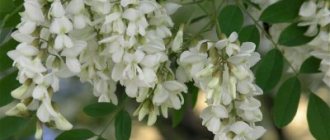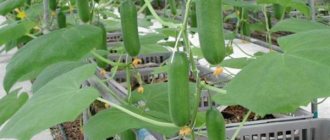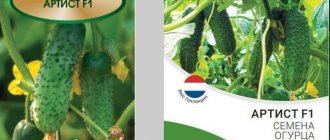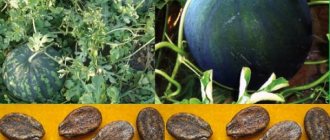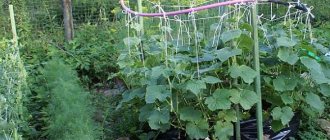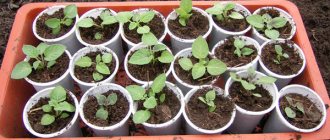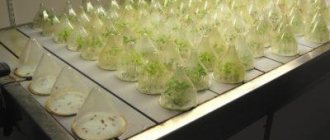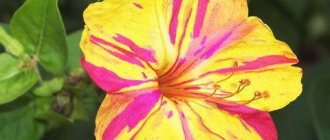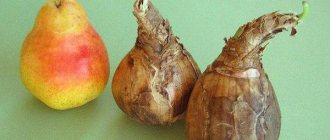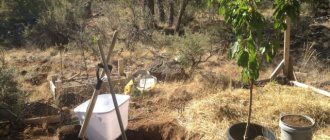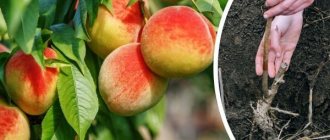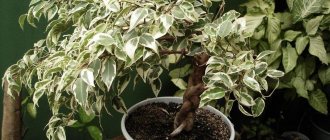What varieties of cucumbers are left for seeds?
Of course, buying ready-made seeds at a gardening store is much more convenient, but if you come across a variety that you like, you want to breed it. Any variety of cucumbers is suitable for collecting seeds. The only condition is that the variety should not be a hybrid, but naturally obtained. This is easy to check. The packaging contains markings – F1/F2. This means that the variety is hybrid. It is not worth getting the seeds of such vegetables. You can get acquainted with hybrids using the example of cucumber variety Shosha F1.
Cucumber varieties with this mark are not suitable for collecting seeds
Vegetables of any variety obtained naturally from the seed are used for seeds. Such cucumbers only improve their quality with each sowing.
Good to know:
Warm bed for cucumbers in open ground
Which cucumbers to leave for seeds: selection rules
Some gardeners believe that the first ripe cucumber should be left for seeds. But this is optional. Any healthy cucumber you like will be suitable for the seed.
It should not be picked until it is fully ripe. A ripe cucumber becomes yellow and soft.
It is much more important to determine the sex of a cucumber for seeds, rather than the time of its collection. Women's ones are suitable for this - with a square cross-section, that is, such vegetables have four chambers with seeds (tetrahedral). Examine the cucumbers carefully. Seeds from male fruits will not produce abundant harvests, plus they will bloom with male flowers. Male fetuses have three chambers.
The cucumber is male at the bottom, female at the top.
Selected vegetables are marked immediately, plus a board is placed under them so that they do not rot prematurely. You need to pick a seed cucumber when its color changes to yellow-brown and the stalk dries out.
You can already extract the seeds from such a cucumber.
Cut the picked cucumber strictly in half lengthwise into two parts.
You need to take seeds only from the front third of the vegetable.
Glass, wooden or enamel containers are suitable for collection.
Selection of seed cucumbers
Before collecting cucumber seeds at home, you need to consider that not all varieties of vegetables are suitable for this. Hybrids and parthenocarpics do not have seed material suitable for propagation. In the first case, plants are obtained by crossing several varieties. An attempt to reproduce such vegetables leads to the loss of parental characteristics. Parthenocarpic varieties of modern breeding do not produce seeds at all. They are usually small and underdeveloped, so they are not suitable for producing seedlings.
For harvesting, cucumber varieties adapted to local conditions are selected. In this case, preference is given to fruits with four seed chambers. To obtain friendly, strong sprouts, take seeds located in the front third of the cucumber. Seed material is selected from large fruits with a smooth surface. The designated specimens are left hanging on the cucumber vine until the onset of cold weather. With this approach, the seeds have time to undergo natural hardening. A piece of wood or cardboard is placed under the fruits lying on the surface of the soil to prevent rotting.
Advice! In order not to accidentally pick the seed specimen, it is marked by tying a rope. The fruit is left on the vine until fully ripe, when its color becomes yellow or brown. At the same time, it loses its elasticity, becomes soft, and the tail dries out. If the weather is rainy and cool at the time of ripening, the cucumber is picked and left to ripen at home.
Pollinating cucumbers to obtain seeds
All varieties of cucumbers are divided into two types:
- self-pollinating or parthenocarpic;
- bee-pollinated.
In the second case, there is a risk of getting not a pure variety, but a hybrid. This method is suitable if the variety of cucumber does not matter. But if you want to get only a certain species, then you need to carry out manual pollination.
Hand pollination of cucumbers to obtain seeds
To do this, a day before the buds open, carefully tie the male and female flowers together so that insects do not pollinate them. You need to tie 2-3 times more male buds than female ones, so that each female bud is then pollinated by two or three male buds. After a day, remove the cotton wool and begin pollination. This should be done in the morning in dry and warm weather.
Cut off the corollas of male flowers and gently touch them to the stigmas of female flowers. Each flower needs to be pollinated by 2-3 male flowers. Do this as many times as you want to get seed cucumbers. Also, use the last male flower to close the entrance to the female flower, leaving it together with the peduncle and calyx to prevent insects from entering. We have already touched on the topic of male and female flowers in a cucumber and how to identify them in the article Why there are a lot of barren flowers on cucumbers and how to deal with it.
At the end of the procedure, mark the pollinated flowers with multi-colored ribbons.
When to pick cucumber for seeds
You need to wait until the cucumber becomes soft and yellow-brown in color. But each variety may have its own characteristics. After harvesting, the vegetable can ripen for some more time in a dry, warm place. Ripening is allowed over the next 2-3 weeks.
Ripe cucumbers of different varieties may look different
Sometimes it is recommended to pick the seed fruits after frost so that the vegetable undergoes stratification by summer heat and winter frosts. This will help you get a bountiful harvest next year.
How to choose the right cucumbers for collecting seeds
First of all, the varieties of crops that grow in your garden, suit their taste properties, and give good quantitative indicators are distinguished. Thus, precise confidence in the quality of the obtained seed material is ensured. An important nuance is the selection of exclusively varietal crops, and not hybrid ones, which will not bear fruit.
Next, on each individual vine of a healthy, strong plant, 2-3 cucumbers are selected that meet the following conditions:
- large size;
- smooth sidewalls without dents or damage;
- yellow, yellow-brown peel color;
- softened structure;
- dried stalk (tail).
It is recommended to mark cucumbers for seeds in advance, even before they begin to turn yellow. A colored rope, gauze pocket or other marking option will help. A slightly larger number of copies than necessary are selected in case a part rots or accidentally breaks off.
Selected representatives gather as late as possible in the fall. This way the seeds will fully ripen and will also become more resistant to both heat and cold temperatures. If it rains frequently and there is high soil moisture, a wooden stand is placed under the cucumbers.
People's advice, not confirmed by breeders, speaks of the need to select only tetrahedral (female) specimens. Three-sided cucumbers are considered male barren flowers that produce a harvest much later. Also, only half of the vegetable, which was closer to the stalk, is used for seeds in order to avoid bitterness and unpleasant taste in the future.
What do cucumber seeds look like?
After collecting the seeds, inspect them carefully. They are in a special shell, which deteriorates very quickly. This shortens the shelf life of seeds. To remove it, dry the seeds in the sun for 3 days, and then rinse off the residue with water.
We have all seen such seeds in cucumbers
High-quality seeds have the same, uniform color with a light cream tint. Depending on the variety, they can be of different sizes.
Storage Features
If you collected seeds from correctly selected cucumbers and did everything according to the instructions, then there is no doubt about their quality. Sowing ability lasts up to 6-7 years. Collect the dried grains and place them in a clean paper envelope, be sure to sign it so you know what variety is stored there. The room where the seeds are stored should not be cold or humid. When the humidity is more than 60% and the temperature is below 10 degrees, the seeds quickly become damp and are not suitable for sowing. Do not store seed material near heating radiators or on stuffy mezzanines. If the seeds lie at room temperature all winter, their germination will only last for a year.
You can grow seedlings from harvested cucumber seeds every year. Immediately after collection, you should not use them for planting: germination will be low. Before sowing them in the ground, first treat the seeds in a disinfectant solution (soda or saline solutions, potassium permanganate). For good germination, agronomists recommend germinating grains. Place them on a napkin soaked in a growth stimulator, then put them in a dark place and germinate for 4-7 days.
Preparing cucumber seeds is easy, just try once and you will no longer buy expensive bags in the store. Don’t forget to carry out their subsequent preparation before sowing, and you will be guaranteed a rich harvest of crispy, tasty greens.
How to collect cucumber seeds correctly
To separate the seeds, cut the cucumber in half lengthwise. Rake the seeds into a glass, wooden or enamel bowl. Next, follow the following procedure:
- if the cucumber was not juicy enough, add water to the container;
- place them in a warm place so that the mixture ferments and the shell separates;
- keep them there for 48 hours;
- After two days, drain the water, as well as all floating seeds and pulp. Such crops will not work;
- Dry the remaining seeds in the sun or indoors. Lay them out in a thin layer on cardboard or gauze.
Well-dried cucumber seeds can be stored under the right conditions for up to 5-6 years. But we must take into account that the longer you keep them, the more the germination level decreases.
To get the maximum number of female plants and a bountiful harvest, seeds should be planted 3 years after harvest.
Rules for seed procurement
To figure out how to properly collect cucumber seeds, you can watch a training video or get advice from an experienced vegetable grower. In addition, it is important to obtain information not only on how to collect seed, but also on how to ensure its further storage.
Rule 1
To collect seeds, you need to leave overgrown fruits on healthy and strong bushes. Selected cucumbers are tied with ribbons, colored threads, and wrapped in paper. Such additional manipulations are performed to prevent someone in a hurry and carelessly from picking the left fruit.
It is recommended to place a piece of plastic or a small board under the selected cucumber. This will prevent the process of rotting that occurs when the fruit comes into contact with moist soil.
Rule 2
Before picking a cucumber left for collecting seeds from the garden, it is recommended to pay attention to its appearance.
The fruit must:
- acquire a yellow-brown color;
- be huge in size;
- have a dried tail (it indicates that the fruit has absorbed all the nutrients necessary for the seeds).
If the cucumber is large in size, yellow-brown in color, but the tail has not yet completely dried out, it is better to abandon such seed. Unripe seeds will not allow you to grow good seedlings and get an excellent harvest.
Rule 3
The part of the cucumber that comes into contact with the dry tail turns out to be quite bitter in most cases. This bitterness is also transmitted to the seeds located in this part of the fruit.
To eliminate the risk of harvesting bitter cucumbers, it is recommended to cut off the back of the fruit by 4 cm. The remaining part is cut in half and the pulp is removed with a spoon, placing it in a prepared glass jar.
Rule 4
It is important to consider that nature took care of immersing each cucumber seed in a transparent shell. If no action is taken, it is unlikely that long-term seed storage will be possible.
If this shell is removed, the collected seed can be stored for four years. Solving such a problem is not difficult. You need to place the extracted seed pulp in a jar and leave it for 2-3 days. During this time, the fermentation process will start, as a result of which the shell will be destroyed.
After three days, water is poured into the jar and the contents are thoroughly crushed. Such actions make it possible not only to ensure peeling of the shell, but also to sort full-bodied seeds from empty ones. High-quality seeds sink to the bottom of the jar, and empty ones float to the top.
The water is carefully drained, and the good seeds remaining at the bottom are transferred to a sieve and thoroughly washed again.
A plate is lined with plastic film, onto which the washed seeds are placed in a thin layer. The prepared seed material is sent to dry in a warm place.
How to properly dry collected seeds
After removing empty and defective seeds, it is important to dry the remaining seeds properly.
The procedure is as follows:
- rinse them with warm running water;
- lay them out on a clean sheet of paper, cardboard, gauze and leave them in a warm and ventilated area until completely dry. They need to be turned over periodically so that they dry evenly;
- They should not be placed near heating appliances. It is better to provide natural warmth and ventilation.
How to save cucumber seeds for next year
Proper storage of seeds helps preserve their germination for longer. Place the dried seeds in a paper envelope or canvas bag. You can make these yourself or buy them at a specialty store. In any case, choose a material that allows air to pass through well.
Paper bags are suitable for storing seeds.
Don't add too many seeds. If stored tightly, they may deteriorate. Make a tag on each bag with the name of the variety and the date of harvesting.
How to Make a Simple Seed Storage Envelope
It should be stored in a dry, dark place at a temperature of about 18-20 degrees.
How to prepare seeds for planting
The most suitable seed material for placing in the soil is one harvested 2-4 years ago. Using earlier seeds, it is believed that the resulting harvest may be poor or late, since there will be a lot of male barren flowers.
If you only have 1-2 year old seeds, but you really want to plant them, it is advisable to hang the bags from the ceiling in a warm room a couple of months before planting. Some gardeners use the method of calcining the seeds before sowing in the oven (1.5-2 hours at a temperature of 40-50 degrees). But this technique harms future vegetables.
The process of independently harvesting cucumber seeds at home from the existing crop harvest is simple and effective. As a result, you can be sure that you will be able to grow the desired variety with your favorite taste in the garden. In addition, ardent gardeners have the opportunity to experiment and test different variations in seed selection.
How to test cucumber seeds for germination
When the time comes to plant seeds, in order to improve the quality of the harvest, you must immediately sort out the weak, broken and empty ones. They will not produce a harvest.
The verification method is very simple. Dissolve a teaspoon of regular salt in a liter of water. Place the seeds into the solution and stir with a spoon. After half an hour, the fruitful ones will settle to the bottom, and the empty ones will float to the surface. They are collected and thrown away.
There is also a pre-germination method. To do this, a couple of weeks before sowing, the planting material is placed in a damp cloth and left in a dark, cool place until the sprouts appear. Those that do not have them are thrown away.
Signs of readiness of seed cucumber
Even when growing cucumbers, you need to immediately notice suitable fruits. They should not be overgrown, so choose those that best match the varietal characteristics. Seeds ripen approximately 80-100 days after the appearance of the first shoots, not earlier than August when planted in May. Signs of fruit readiness will tell you how and when to collect seeds from cucumbers:
- the fruit has turned yellow, the skin has become brownish, and the diameter has already reached the declared size;
- the stalk has completely dried out. This happens when the cucumber has already absorbed all the nutritional elements;
- the skin becomes soft.
